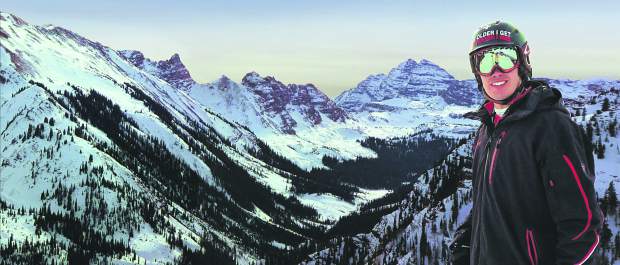Bobby Layman: What I’ve learned from a life-altering ski injury
Special to The Aspen Times

Courtesy photo |
Two days before Christmas 2003, my friend Mike and I were skiing at Snowmass. On the last run of the day, I did a 360-degree jump off a 25-foot tabletop. I was flying through the air when I realized I was off axis. Soon I was free falling from 55 feet. I landed on my head and chest. I tested the law of gravity, and it works really well.
I was unconscious and unable to breathe on my own, so Mike immediately called ski patrol. I can only imagine the fear Mike experienced watching a crowd of people administer life-saving procedures. They cut off my clothes, ran tubes and started an IV. He was terrified and doubtful I would live.
It turned out, his fears weren’t off base. My body stopped functioning at Aspen Valley Hospital, and I was resuscitated by the trauma team. A “flight for life” helicopter transported me to Grand Junction because I was too close to death to make the longer flight to Denver. When the helicopter arrived at St. Mary’s Medical Center, a Catholic priest administered last rights before I was rushed to surgery. Again I was resuscitated, but my family was given little hope for my survival.
I was wearing a helmet when my head hit the ground. Even so, the force was so great that my brain was shaken violently. The result was something called a massive closed head injury.
You see, the healthy human brain is about the consistency of strawberry jam in a jar. Imagine shaking the jar so hard that the jam comes loose from the jar’s sides. That’s what happened. It’s called a brain sheer. Blood vessels in my brain were broken, and bleeding occurred deep in the left side — a brain stem hemorrhage. It caused two problems: A clot caused direct injury to the nerves that control the muscles in my right arm and leg. More dangerous still, the bleeding caused swelling throughout my brain. When the brain swells, it has nowhere to expand and the pressure rises dangerously. An emergency surgery to place a “brain drain,” or intracranial shunt, saved my life.
When I hit the ground that day, I also injured the left side of my chest and lung. The impact was so hard that it caused the delicate, spongy tissue in my left lung to bleed. That’s called a pulmonary contusion.
In addition to the shunt, I had a stomach tube for food, catheters to allow me to urinate, bowel programs and eight different trachs in my neck for breathing because I would vomit each time I moved my head or neck. I had hundreds of IVs, CT scans, MRIs, X-rays, an injection in my vocal chords, five casts on my arm for spasticity and phenol injections in my arm for tone. Fighting life-threatening fevers, seizures, pneumonia, other infections, diarrhea for six weeks, vomiting for a month and a weight loss of more than 45 pounds kept my body busy.
I spent three weeks in an intensive care unit, and a total of six months in four hospitals. I rode in eight ambulances, one helicopter and one jet ambulance. I don’t remember any of them. I only recall 45 days of the half-year I was hospitalized.
The day of my crash I was a high school sophomore, a varsity soccer player, involved with my church, an extreme skier, horseback rider, bicyclist and bass guitar player. When I returned, I was a handicapped youth. Your social life really takes a hit when you become disabled.
The journey of healing from a traumatic brain injury is forever. I will never be the same person or athlete I was before my crash. Hopefully, I’ll be a better person.
I quickly found opportunities to pursue that better life. Eleven months after my crash, I returned to skiing with Challenge Aspen, an adaptive ski program for the disabled. I ski three days a week, and I even hike and ski Highlands bowl. It’s once again my passion, thanks to this program that has changed by disability into ability. I began training with Challenge Aspen to become a certified adaptive ski instructor. That required many hours, on and off snow, learning about disabilities and the medications that treat them. It required a lot of work to perfect my functional skiing so I could teach others. But after three years of study, I passed my exam and became a professional ski instructor of America, alpine and adaptive level one.
Last winter I taught skiing for Aspen Ski Co.’s Snow Cubs program. As a motivational speaker, I represent Aspen Ski Co., Challenge Aspen, the Brain Injury Association, Think First, Valley Life for All and area hospitals. I urge you to become a community volunteer. I’ve gained so much: The networking, job opportunities, skills, friends and a good-looking resume are all bonuses on top of the fulfillment I find in volunteering. The rewards you reap are endless.
Whatever your passion, do it. But learn from my experience: Take it down a notch. Don’t show off to impress someone. Do it like there is a tomorrow.
Bobby Layman graduated from Rifle High School in 2006, and received an associate degree in outdoor education from Colorado Mountain College in 2009. He is a paraprofessional teacher focused on special-needs students in Re-2, and spends summers working for the town of Silt. He sumbitted this essay.
Maria Bamford’s 2025 comedy tour comes to Willits
If laughter really is the best medicine, Maria Bamford delivers a prescription.
PHOTOS: Closing day party on Ajax brings end to Aspen’s ski season
The ski season is officially a wrap here in the Roaring Fork Valley, with Sunday’s annual closing day party on Aspen Mountain the winter’s final hurrah.









